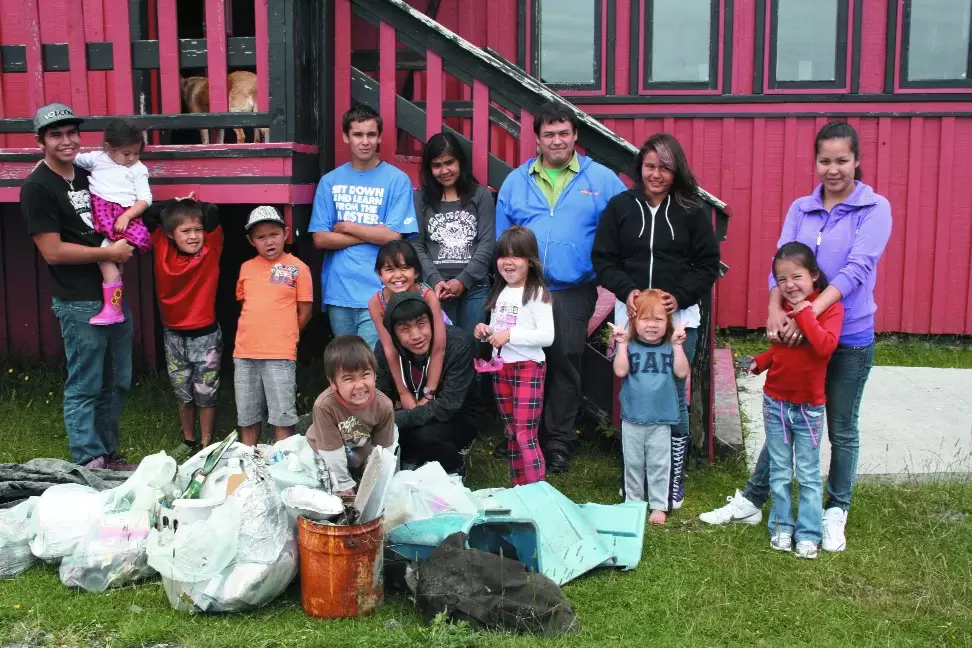On July 19 and 20, the children of the Tla-o-qui-aht community of Opitsaht helped make their community a cleaner and more environmentally friendly place to live. With the help of the University of Victoria’s Science Venture program, the children took part in a beach cleanup that formed two days of a science camp organized and implemented by Uu-a-thluk. The camp has been running for six years in various Nuu-chah-nulth communities. According to Norine Messer, Capacity Building Coordinator with Uu-a-thluk, the main goal of the camps is to, “get kids excited about science,” while “marry[ing] that with validating, honouring, and including Nuu-chah-nulth beliefs.”
Science Venture instructors Sarah Welton and Lucas Kavanagh kicked off the activities with a presentation. The children learned how chemicals washed off of garbage and can leach into the soil, polluting their drinking water. They also learned how people can get sick by eating animals that have eaten garbage.
As one camper noted, “It’s pretty gross to eat or drink things that have had garbage in them!”
The children then learned that animals such as birds and turtles eat plastic bags because they confuse them with jellyfish. Once ingested, plastic bags remain in the stomach, and eventually the animals starve to death. This part of the presentation touched many of the children and would influence later activities.
After the presentations came the big task of the day: the beach cleanup. With biodegradable bags in hand, the children enthusiastically gathered garbage off the beach. At the same time, the children participated in a scavenger hunt devised by Uu-a-thluk biologist, Katie Beach. The hunt was designed to test the children’s understanding of common pollutants, as well as their scientific knowledge. The children in my group demonstrated their knowledge with ease. Most of the questions I asked were answered before I could finish the question!
As an Uu-a-thluk intern, part of my job was to root these lessons in our culture. I shared this job with Damon Rampanen, another Uu-a-thluk intern. To do this, we used Nuu-chah-nulth words to describe certain concepts or animals. Damon taught the children about the concepts of iisaak (respect) and hishuk ish ts’awalk (everything is one), and how they were related to nisma (the land). Damon and I taught the children the Nuu-chah-nulth words used to describe the six stages of a Pacific salmon’s life cycle. We incorporated these words into games that cemented the children’s connection to their land, culture, and roles as land and water stewards.
At the end of the day the children were asked to draw posters explaining why a clean environment was important to them. This was to get them thinking about the anti-littering signs they would be making the following day. With permission from the Ha’wiih, these wooden signs would be placed around the community.
Many children drew posters urging community members not to throw plastic into the water, just in case sea turtles might confuse them with jellyfish and eat them. On hearing about the signs that the children were painting, Tla-o-qui-aht elder, John Tom said, “You know, the amount of garbage on the beach has decreased over the last couple of years, and signs could really help get rid of it all.”
The children shared a similar optimism, which spilled over onto the signs they painted in bright, stunning colours. In short, this project belonged to the children; we were just there to guide and assist them.
The signs were as expressive and energetic as the children, and contained all the lessons they had learned over the last few days. According to science camp participant, Carol Curley, the most important lesson she learned from the science camp was, “it’s bad to litter on the beach because it can hurt the other animals and the water.”
Such insight bodes well for Opitsaht’s future as an environmentally friendly, vibrant, and healthy community.
Special thanks to the BC Capacity Initiative and private donors for helping make this project possible.
By Johnnie Manson,







